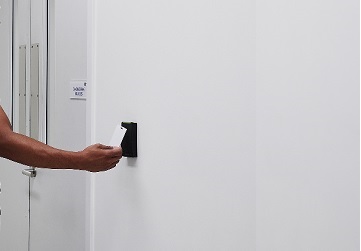Access
control, just as it clearly states, is a term that refers to the act of
restricting entry into a building or particular room through technological
means. It is a system that gives access to or
controls who enters and exits. Giving access control assumes authorization to
use. There are various types of Access control:
i.
Physical
Access control
ii.
Electronic
Access control
PHYSICAL ACCESS CONTROL
Physical
access control is implemented through mechanical locks and keys. The
limitations with mechanical locks, which make them not fully functional in this
day, are as follows:
i.
Mechanical
locks do not restrict the key holder to specific dates and time.
ii.
Mechanical
locks and keys do not provide records of keys used, the user or the specific door that was
accessed.
iii.
Mechanical
locks and keys can easily be duplicated and transferred to unauthorized persons
ELECTRONIC ACCESS CONTROL
Electronic
access control uses technology and computers to solve the problems of
mechanical locks and keys. Credentials
which require verification are used in place of mechanical keys. The electronic
system grants access based on the credentials submitted. When
access is granted, the door is unlocked for an amount of time and activity is
recorded. When access is denied, the door remains unlocked and attempted access
is recorded. The
system also monitors the door and alarm; it notes if the door is being forced
open or held open for too long after being unlocked while access was granted.
ELEMENTS OF AN ACCESS CONTROL SYSTEM
Access
control systems has three distinct elements that define how it works, they are;
Identification, authentication and authorization.
IDENTIFICATION:
The purpose of access control is to protect a building / property/ room. The
system therefore has to be able to identify the individual attempting to gain
access to secured areas.
AUTHENTICATION:
After the system has identified the individual, it is vital that their identity
is authenticated to ensure that the right person is granted access. The various
methods by which authentication can be achieved include passwords, fingerprints
encryption key, smartcards.
AUTHORIZATION:
Once authentication is successful, access control systems are then able to
grant individuals access to restricted areas, based on fulfilled criteria.
BENEFITS OF ACCESS CONTROL
Protects
against unwanted guests: Operating a business/ organization can give visitors
the opportunity to come and go undetected. The benefits of access control
system are that unauthorized guests cannot get in, because the door needs
credentials to grant them access.
Reduces
risks of potential theft: Company’s assets, expensive equipment or office
supplies are protected by controlling who accesses them. Since employees are
also aware that access to the equipment are tracked, it serves as a deterrent
to feel the need to steal.
Keeps
track of who comes and goes: Access control systems provide data on who enters
and exits a room, how long they had access and when they had access.
Prevents
data breaches: Sensitive health information, financial records and client data
are usually stored and secured at organizations and may be accessed by
unauthorized individuals, restricting access to this information is vital for
the organization.
Maintains
electronic logs for review and future reference: The system records individual
access and activities performed when access was granted.
Gets
rid of traditional keys: The use of traditional keys has a few setbacks and
disadvantage, the larger the building, the more locks you need and the bulkier
the key ring. Traditional keys can also be easily duplicated and get in the
hands of unauthorized individuals.
Saves
money and energy: With access control systems, you save money on duplicating
multiple keys and paying of security personnel, the system can authenticate and
identify before granting access, without the need of a security personnel.
Provide
employees the freedom to work when they need to: When employees have different
shifts/ work time, access control systems enable them to come in and go
conveniently. People can come in early and not have to wait for whoever has the
keys, managers also do not have to stay late just to lock up the place.

 August 31, 2019 - BY Admin
August 31, 2019 - BY Admin